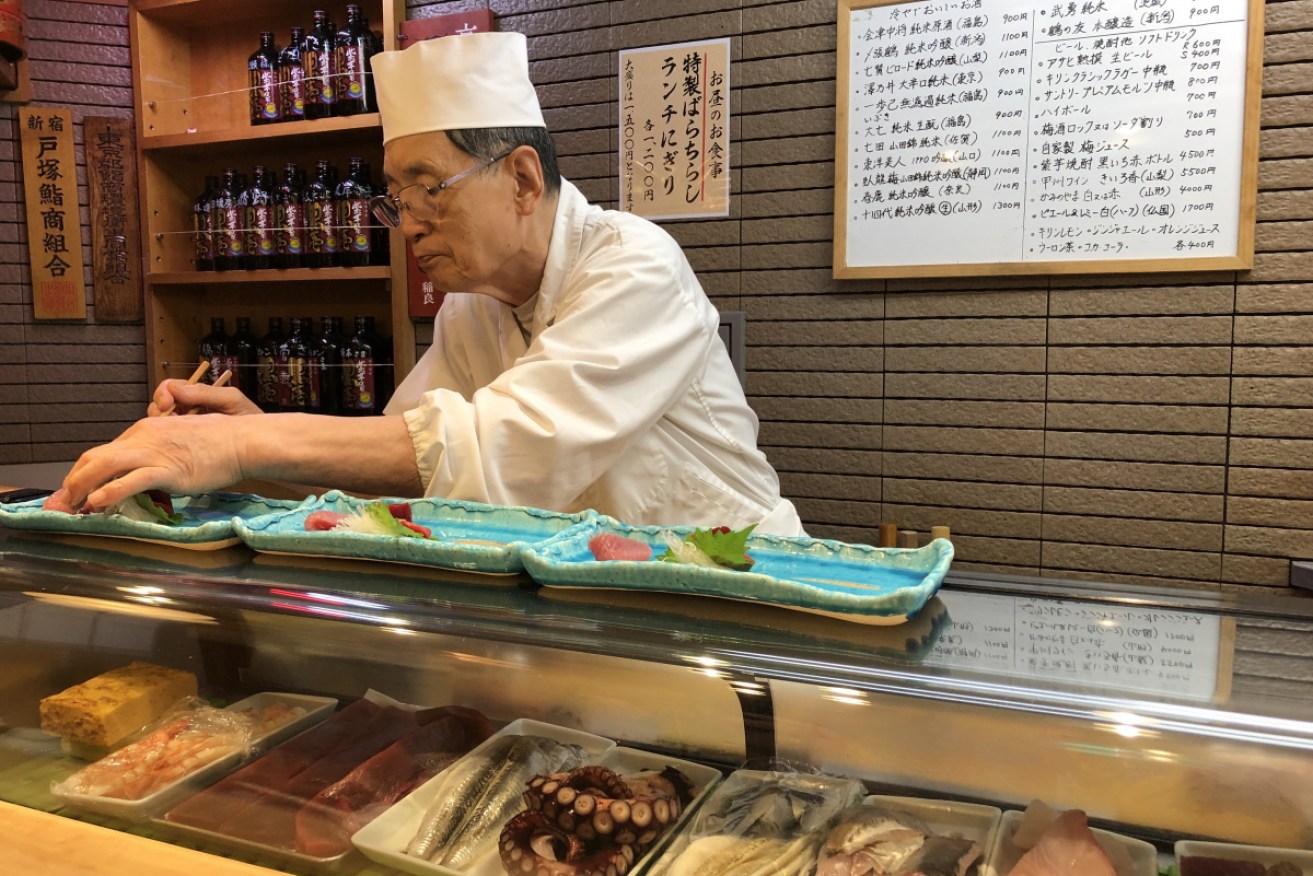How to eat sushi like a local


The 85-year-old sushi master chef at work.
It takes two subways, a suburban shortcut and a walk through winding back streets to reach the Tokyo sushi restaurant where we are to dine.
Inside, just nine seats line the bar. Opened in 1868, it has been run by the same family for six generations, the 85-year-old grandfather still works beside his son and grandson.
There’s no English menu, it’s not in the guidebooks, or on Instagram. Nor can I work out the name – the chef’s business card says one thing, our interpreter calls it something else.
We’re here to experience “Sushi University”, the brainchild of businessman and passionate traveller, eater and sushi scholar Tetsuya Hanada.
Through his travel company, Tabimori, Hanada offers travellers to Tokyo the chance to experience dinner at the counter of the city’s premier sushi restaurants. Interpreters will translate as the chefs explain the traditions, techniques and etiquette of one of the world’s best-loved foods as they make your dinner, piece by intricate piece.

Three generations of the Yasui family: Eiichi Yasui (centre) with his father (left) and son. Photo: Janne Apelgren
For, as we learn, sushi is a lot more than just raw fish on rice. Mr Hanada tells us there are many customs around the way and order in which it should be eaten. And the preparation of the fish can sometimes take days or weeks.
The senior sushi chef laughs as he gives us a lesson, through mime, of what not to do with our sushi: Using chopsticks to separate the fish from the rice, dunking the rice in soy, leaving grains of rice in the soy bowl.
In fact, we should not dip or garnish our sushi at all. The chef has already chosen what complements each piece and incorporated that –from soy and sake, to wasabi, olive oil and salt, or sudachi (a Japanese citrus).
We’re told it’s best to eat with our fingers – and that each piece of sushi should be consumed, in one mouthful, within 10 seconds of the chef passing it over the counter.
The atmosphere in the Yasuis’ restaurant is cheerful and relaxed. The chefs chat easily with customers – three businessmen on one side of us, a couple on the other.
We will eat 17 pieces of nigiri sushi the chefs make in front of us. We begin with unctuous broad velvet shrimp, then Japanese egg cockle, both quite rare.

This $50 piece of nigiri uses a rare, expensive fish called shinko.
Tiny Japanese icefish form an intricate topping to one piece – translator Jenn Yamazaki tells us they are sticky and difficult to work with.
Then come flathead and sea bream, seared pen shell blanketed in nori, three types of increasingly delicious tuna, sea urchin wrapped in sea bream – chef Eiichi Yasui’s invention. His father is known for inventing the cucumber roll.
Translator Jenn Yamazaki tells us these chefs are known for their inventiveness and experimentation. We ask Chef Yasui what he thinks of ‘innovations’ like sushi train restaurants and the California roll?
Turns out he approves. Yasui thinks it’s good other countries put their own spin on sushi. After all, Japanese have appropriated other cuisines, he says, such as Indian curries, and made their own versions.
Through the interpreter he explains the misconception that sushi is just raw fish on rice: “There’s a lot of ‘cooking’ in sushi. The fish may be marinated, seared, rested, aged to develop its flavour.”
Sushi University proprietor Mr Hanada tells us later that some sushi fish are rested for as long as 30 days.
“If you’re going to pay so much for a sushi experience, it would be a shame to just leave it at whether each piece tastes good or not. For example, art museums are a lot more fun if you have knowledge of the subject. Sushi restaurants are the same,” he says.
“For instance, today’s bastard halibut has been rested for two days in the fridge to gain more umami. Letting it rest just for one day is not enough. On the other hand, you cannot let it rest over three days, which makes the crunchy texture less.”
Mr Hanada was inspired to set up Sushi University by his own travels and love of food. His first overseas trip was to Australia after graduating from university, and he has now visited more than 90 countries.

Japanese ice fish.
When we ask him about Australian sushi, he’s diplomatic. But he’s not a fan of the wasabi served at many overseas sushi restaurants, explaining it’s not wasabi but powdered horseradish, colouring and additives. (Once home, I check the ingredients of a popular ‘wasabi’, and there’s actually no wasabi in it.)
“Real wasabi is pungent, but it lasts for a very short time and after it passes through the nose, it leaves you with a cool sensation, and there is no feeling of discomfort,” Mr Hanada says.
“The stimulation increases your appetite.”
Revealing himself as a connoisseur of the real thing, he adds: “The taste of the wasabi even changes depending on whether it is turned clockwise or counter-clockwise while grating.”
As we leave, bound for the subway, the chefs bow as they farewell us. But the privilege, of learning as we eat an extraordinary meal in a special pocket of Tokyo, has been all ours.
About Sushi University
Sushi University courses and dinners are graded basic, intermediate, advanced and master. Basic costs Yen 12,000 (about $160) per person, and is held in a restaurant where clients might enjoy an after-work dinner. Master level costs Yen 62,000 (about $830) and will feature 20 toppings over several hours.
Bookings must be made via email and paid for in cash. Translators will meet guests at their hotels to travel via train to the chosen restaurant.








